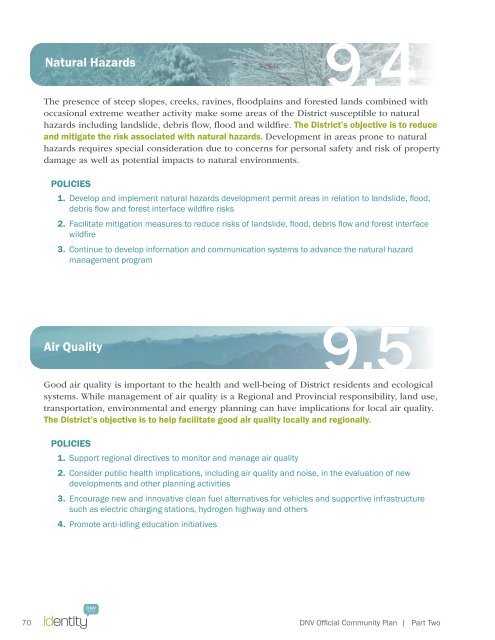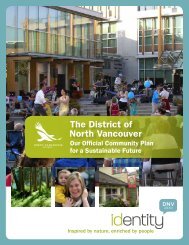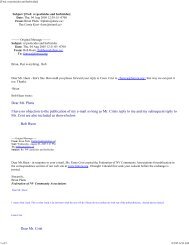Official Community Plan - District of North Vancouver
Official Community Plan - District of North Vancouver
Official Community Plan - District of North Vancouver
You also want an ePaper? Increase the reach of your titles
YUMPU automatically turns print PDFs into web optimized ePapers that Google loves.
Natural Hazards<br />
9.4<br />
The presence <strong>of</strong> steep slopes, creeks, ravines, floodplains and forested lands combined with<br />
occasional extreme weather activity make some areas <strong>of</strong> the <strong>District</strong> susceptible to natural<br />
hazards including landslide, debris flow, flood and wildfire. The <strong>District</strong>’s objective is to reduce<br />
and mitigate the risk associated with natural hazards. Development in areas prone to natural<br />
hazards requires special consideration due to concerns for personal safety and risk <strong>of</strong> property<br />
damage as well as potential impacts to natural environments.<br />
Policies<br />
1. Develop and implement natural hazards development permit areas in relation to landslide, flood,<br />
debris flow and forest interface wildfire risks<br />
2. Facilitate mitigation measures to reduce risks <strong>of</strong> landslide, flood, debris flow and forest interface<br />
wildfire<br />
3. Continue to develop information and communication systems to advance the natural hazard<br />
management program<br />
Air Quality<br />
9.5<br />
Good air quality is important to the health and well-being <strong>of</strong> <strong>District</strong> residents and ecological<br />
systems. While management <strong>of</strong> air quality is a Regional and Provincial responsibility, land use,<br />
transportation, environmental and energy planning can have implications for local air quality.<br />
The <strong>District</strong>’s objective is to help facilitate good air quality locally and regionally.<br />
Policies<br />
1. Support regional directives to monitor and manage air quality<br />
2. Consider public health implications, including air quality and noise, in the evaluation <strong>of</strong> new<br />
developments and other planning activities<br />
3. Encourage new and innovative clean fuel alternatives for vehicles and supportive infrastructure<br />
such as electric charging stations, hydrogen highway and others<br />
4. Promote anti-idling education initiatives<br />
70 DNV <strong>Official</strong> <strong>Community</strong> <strong>Plan</strong> | Part Two




